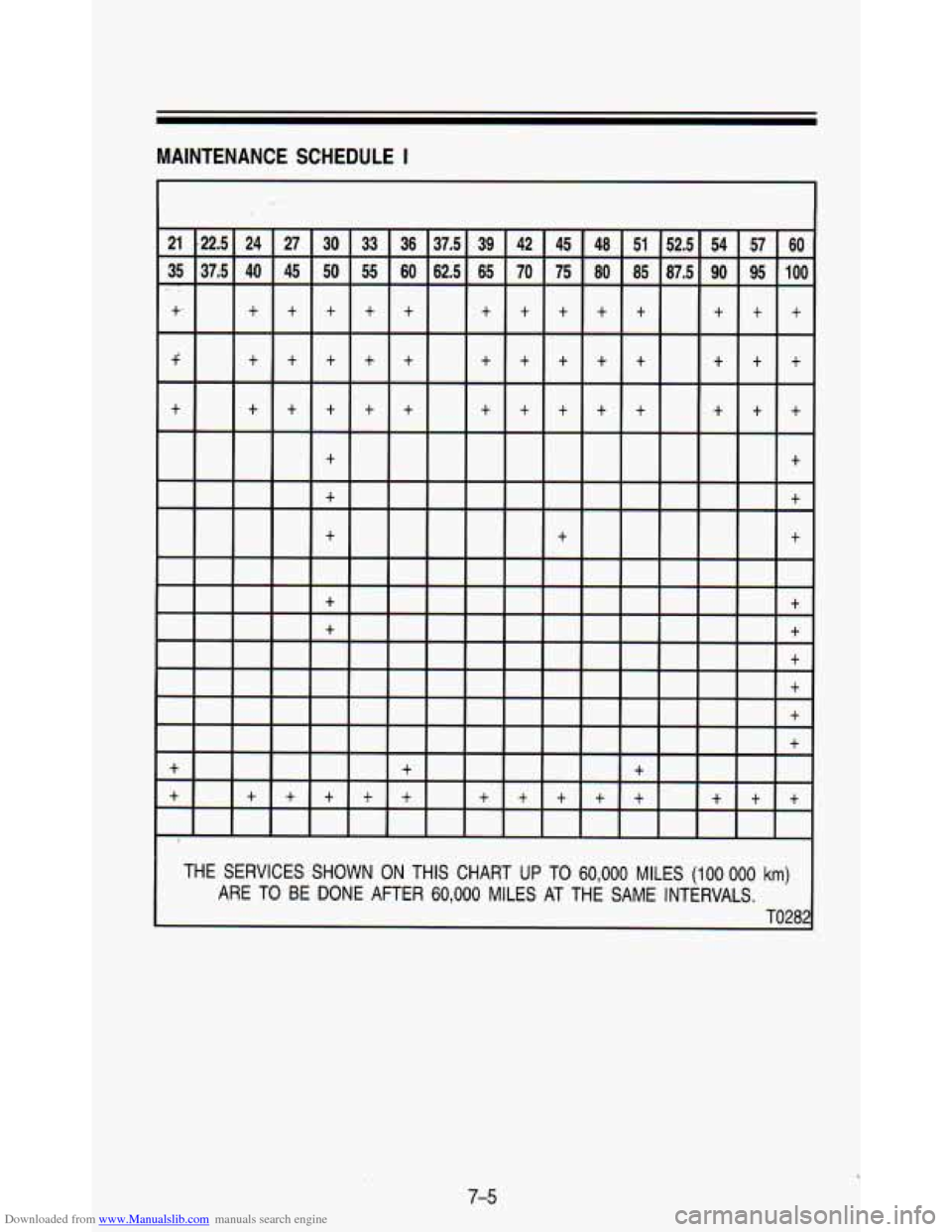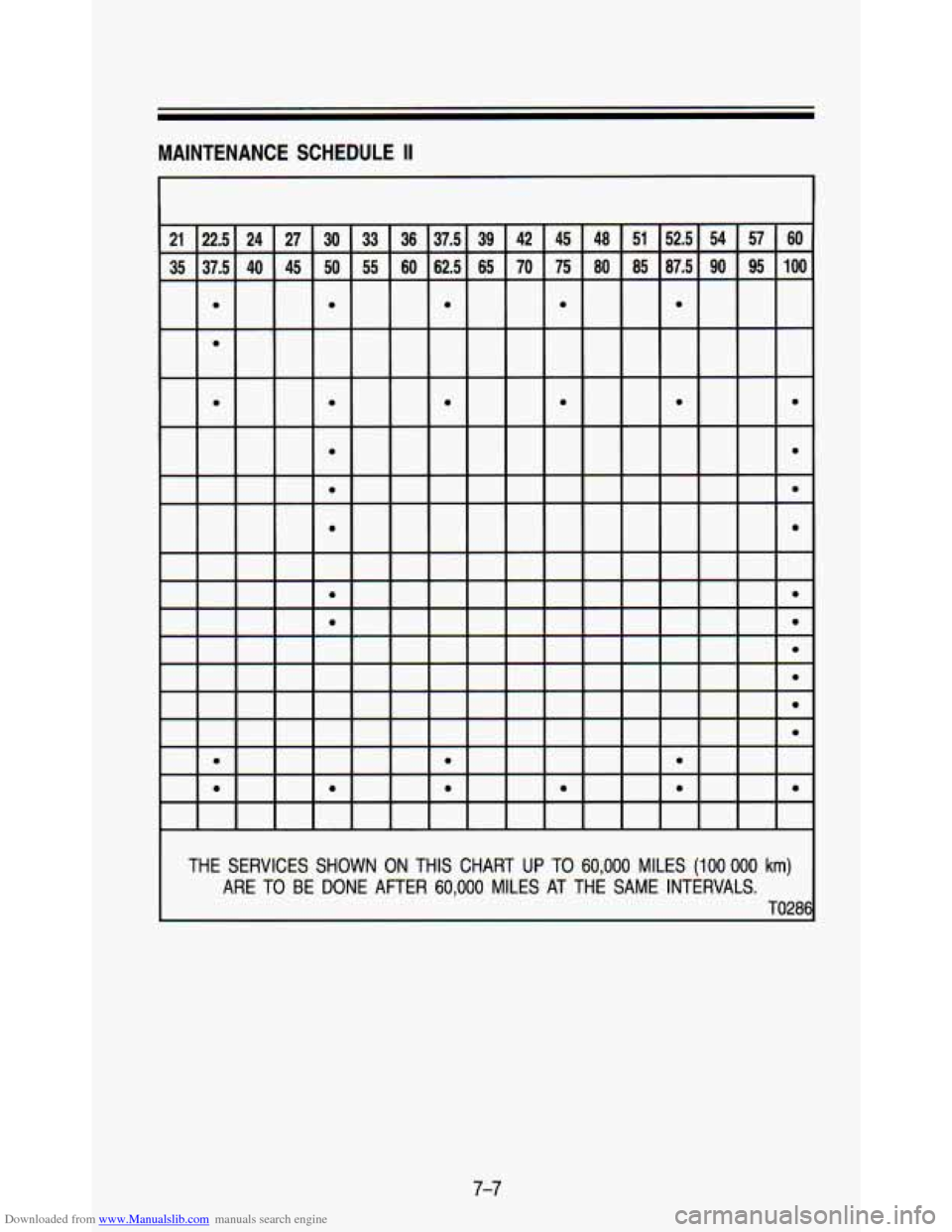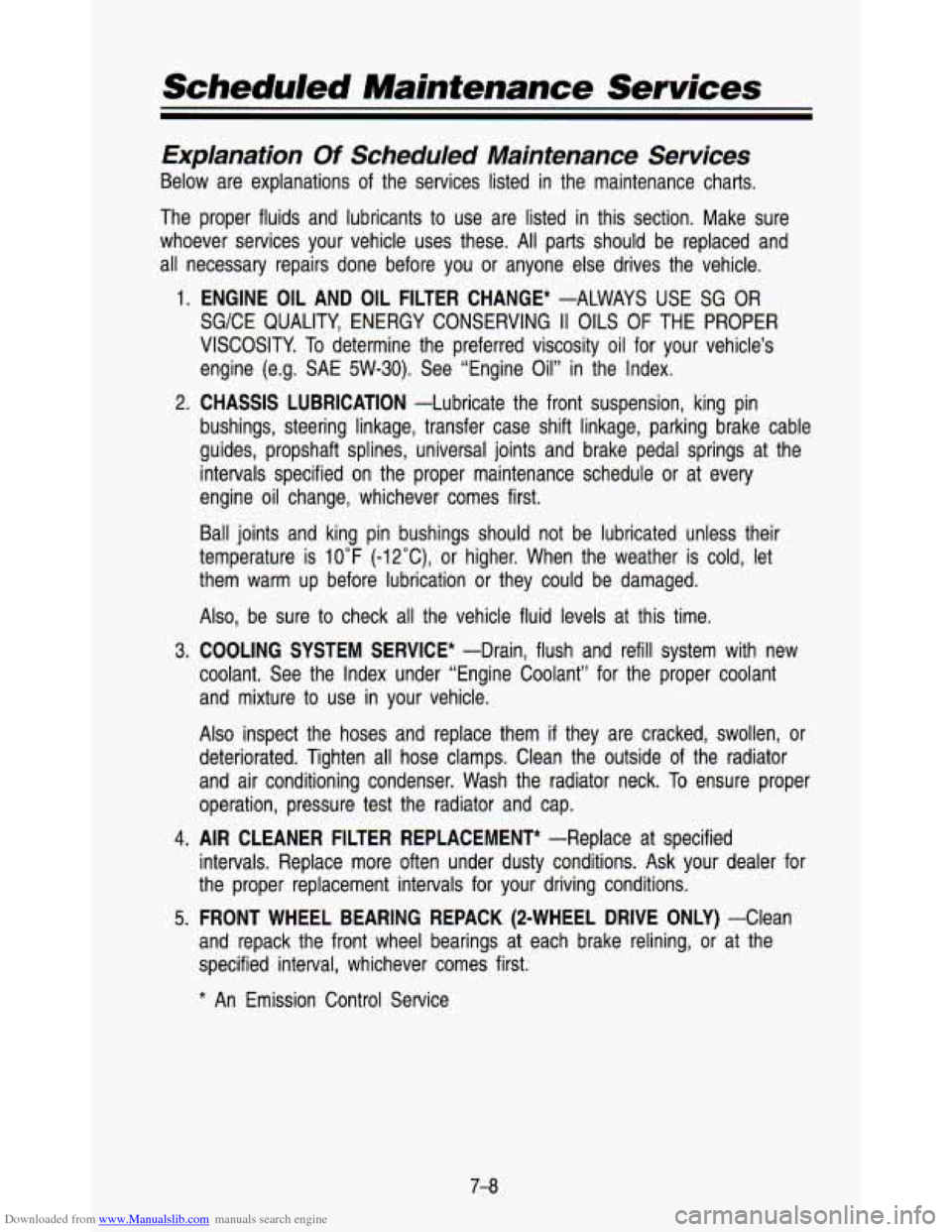1993 CHEVROLET ASTRO PASSENGER service interval
[x] Cancel search: service intervalPage 274 of 345

Downloaded from www.Manualslib.com manuals search engine Service & Appearance Care
PO400
3. Press the tab and turn the socket to the left to remove the socket from
the bezel.
If the socket does not have a tab, turn the socket to the left to remove
the socket from the bezel.
4. Pull out the bulb and replace it with the new bulb.
5. Reverse steps 1-3 to reinstall the taillight.
Other Maintenance Items
Front Suspension and Steering Linkage
The Maintenance Schedule will tell you how often to lubricate the fittings. See
“Recommended Fluids and Lubricants” in the Index for the proper lubricant to
use.
Front Wheel Bearings (Two-Wheel Drive)
If your vehicle is two-wheel drive, the front wheel bearings must \
be cleaned
and repacked at certain intervals. The Maintenance Schedule will tel\
l you how
often this must be done.
Single Belt Accessory Drive
Your new vehicle uses a serpentine belt that is lighter, more durable and fuel
efficient than systems with several belts.
The belt runs over
or around the pulleys on the engine. A tensioner is used
to keep the belt tight at all times. The tensioner also makes replacing the
belt easier.
If you need to replace the belt, be sure to get the correct
6-38
Page 311 of 345

Downloaded from www.Manualslib.com manuals search engine MAINTENANCE SCHEDULE I
t
t
THE SERVICES SHOWN ON THIS CHART UP TO 60,000 MILES (100 000 km)
ARE TO BE DONE AFTER 60,000 MILES AT THE SAME INTERVALS.
TO282
7-5
Page 313 of 345

Downloaded from www.Manualslib.com manuals search engine MAINTENANCE SCHEDULE II
€€€
36
62.5 60
37.5
e
0
e
0
39
65
THE SERVICES SHOWN ON THIS CHART UP TO 60,000 MILES (100 000 km)
ARE TO BE DONE AFTER 60,000 MILES AT THE SAME INTERVALS. T028t
7-7
Page 314 of 345

Downloaded from www.Manualslib.com manuals search engine Scheduled Maintenance Services
Explanation Of Scheduled Maintenance Services
Below are explanations of the services listed in the maintenance charts.
The proper fluids and lubricants to use are listed in this section. Make sure
whoever services your vehicle uses these. All parts should be \
replaced and
all necessary repairs done before you or anyone else drives th\
e vehicle.
1. ENGINE OIL AND OIL FILTER CHANGE* -ALWAYS USE SG OR
SG/CE QUALITY, ENERGY CONSERVING II OILS OF THE PROPER
VISCOSITY.
To determine the preferred viscosity oil for your vehicle’s
engine (e.g. SAE 5W-30). See “Engine Oil” in the Index.
bushings, steering linkage, transfer case shift linkage, parking \
brake cable
guides, propshaft splines, universal joints and brake pedal spri\
ngs at the
intervals specified on the proper maintenance schedule or at ev\
ery
engine oil change, whichever comes first.
2.
CHASSIS LUBRICATION -Lubricate the front suspension, king pin
Ball joints and king pin bushings should not be lubricated unl\
ess their
temperature is
10°F (-12”C), or higher. When the weather is cold, let
them warm up before lubrication or they could be damaged.
Also, be sure to check all the vehicle fluid levels at this time.
3.
COOLING SYSTEM SERVICE* -Drain, flush and refill system with new
coolant. See the Index under “Engine Coolant” for the pro\
per coolant and mixture to use in your vehicle.
Also inspect the hoses and replace them
if they are cracked, swollen, or
deteriorated. Tighten all hose clamps. Clean the outside of the radiator
and air conditioning condenser. Wash the radiator neck.
To ensure proper
operation, pressure test the radiator and cap.
4. AIR CLEANER FILTER REPLACEMENT* -Replace at specified
intervals. Replace more often under dusty conditions. Ask your \
dealer for
the proper replacement intervals for your driving conditions.
5. FRONT WHEEL BEARING REPACK (2-WHEEL DRIVE ONLY) -Clean
and repack the front wheel bearings at each brake relining, or at the
specified interval, whichever comes first.
* An Emission Control Service
Page 315 of 345

Downloaded from www.Manualslib.com manuals search engine 6. TRANSMISSION SERVICE
Change the transmission fluid and filter every 15,000 miles (2\
5 000 km).
If the vehicle is mainly driven under one or more of these conditions:
In heavy city traffic.
Where the outside temperature regularly reaches 90°F (32°C\
) or
In hilly or mountainous terrain.
Frequent trailer pulling.
Uses such as taxi, police, delivery or other commercial service\
.
higher.
If the vehicle is not used mainly under any
of these conditions, change
the fluid and filter every 30,000 miles
(50 000 km). See “Automatic
Transmission Fluid’’ in the Index for more information.
7. FUEL FILTER REPLACEMENT* -Replace the fuel filter at the specified
interval or sooner
if clogged.
8. SPARK PLUGS REPLACEMENT* -Replace spark plugs with the type
listed in Section
6. See “Specification Charts’’ in the Index.
9. SPARK PLUG WIRE INSPECTION* -Clean wires and inspect for burns,
cracks or other damage. Check the wire boot
fit at the distributor and at
the spark plugs. Replace wires as needed.
10.
ENGINE TIMING CHECK AND DISTRIBUTOR CHECK -Adjust timing to
underhood label specifications. Inspect the inside and outside of the
distributor cap and rotor for cracks, carbon tracking and corro\
sion. Clean
or replace as needed.
cap and lines for damage or leaks. Remove fuel cap, inspect g\
asket for
an even filler neck imprint, and any damage. Replace parts as \
needed.
12.
ENGINE ACCESSORY DRIVE BELT INSPECTION* -Inspect belt. Look
for cracks, fraying, wear, and proper tension. Adjust or replac\
e as needed.
11.
FUEL TANK, CAP AND LINES INSPECTION* -Inspect the fuel tank,
* An Emission Control Service
7-9
Page 319 of 345

Downloaded from www.Manualslib.com manuals search engine Periodic Maintenance Inspections
Listed below are inspections and services which should be performed at least
twice a year (for instance, each spring or fall). You should let your
GM
dealer’s service department or other qualified service center \
do these jobs.
Make sure any necessary repairs are completed at once.
Steering and Suspension lnspectiont -Inspect front and rear suspension
and steering system for damaged, loose or missing parts, signs \
of wear or
lack of lubrication. Inspect power steering lines and hoses for proper \
hook-up,
binding, leaks, cracks, chafing, etc. (On vehicles equipped wit\
h manual
steering gear, check for seal leakage.) Lubricate the steering linkage.
Accelerator Control System -Lubricate all pivot points with engine oil,
except the
TBI throttle shaft. Do not lubricate the cam pulley. Remove all
external deposits from pulley.
Do not oil any accelerator or cruise control
cables. Replace any cables that have high effort or excessive wear.
Exhaust System Inspection -Inspect the complete system including the
three-way catalytic converter. Inspect the body near the exhaust system. Look
for broken, damaged, missing or out-of-position parts, as well \
as open seams, holes, loose connections or other conditions which could cause \
a heat buildup
in the floor pan or could let exhaust fumes seep into the passenger
compartments.
Drive Axle Service -Check readfront axle fluid level and add as needed.
Check constant velocity joints and axle seals for leaking.
Transfer Case (all-wheel drive) lnspectiont -Every 12 months or at oil
change intervals, check front axle and transfer case and add l\
ubricant when
necessary. Oil the control lever pivot point (except
L Van) and all exposed
control linkage. Check vent hose at transfer case for kinks an\
d proper installation.
tA fluid loss in these systems may indicate a problem. Have them inspected
and repaired at once.
7-1 3